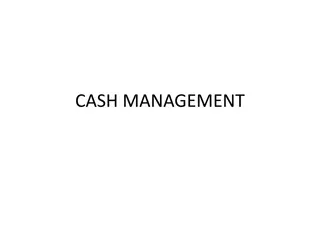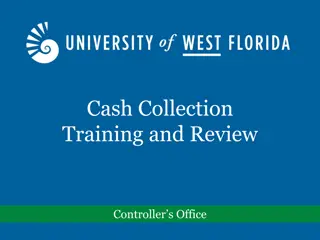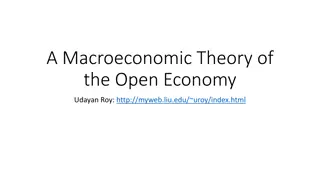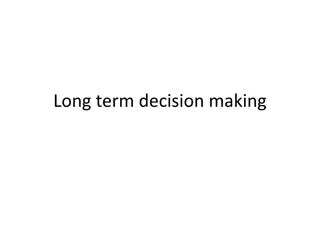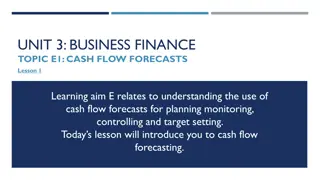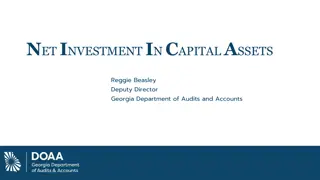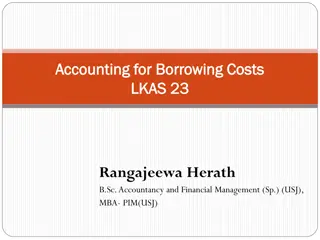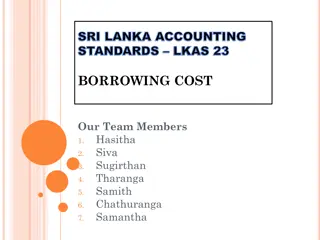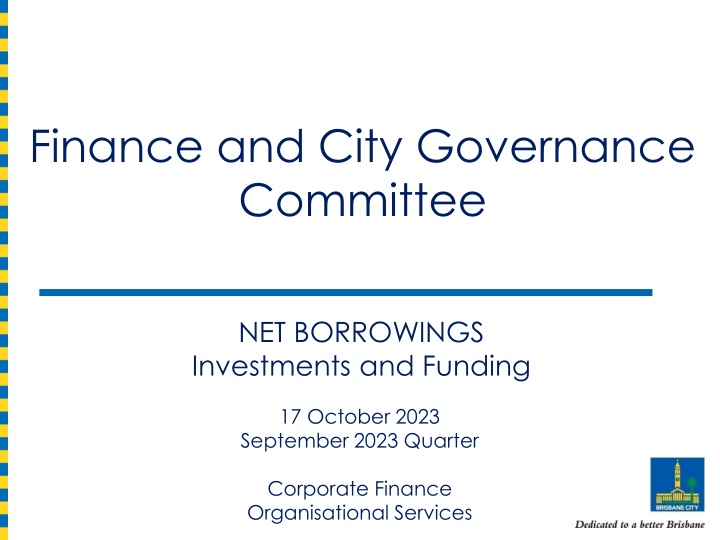
Economic Outlook and Trends: Global and Domestic Analysis
Explore the latest economic forecasts and trends including global GDP growth projections, inflation rates, domestic economy insights from Australia, and labor market updates. Gain valuable insights into the financial landscape for informed decision-making.
Download Presentation

Please find below an Image/Link to download the presentation.
The content on the website is provided AS IS for your information and personal use only. It may not be sold, licensed, or shared on other websites without obtaining consent from the author. If you encounter any issues during the download, it is possible that the publisher has removed the file from their server.
You are allowed to download the files provided on this website for personal or commercial use, subject to the condition that they are used lawfully. All files are the property of their respective owners.
The content on the website is provided AS IS for your information and personal use only. It may not be sold, licensed, or shared on other websites without obtaining consent from the author.
E N D
Presentation Transcript
Finance and City Governance Committee NET BORROWINGS Investments and Funding 17 October 2023 September 2023 Quarter Corporate Finance Organisational Services
Global Economy Outlook OECD Forecast Real GDP Growth Projections The Organisation for Economic Co-operation and Development s (OECD) forecast for global growth has improved to 3% for 2023, up from last quarters forecast of 2.7%. The 2023 outlook for the US has been revised up to 2.2% (from 1.6%), whilst China has been revised down to 5.1% (from 5.4%). 2022 3.3 3.7 3.0 3.4 4.1 2.1 2023 3.0 1.8 5.1 0.6 0.3 2.2 2024 2.7 1.3 4.6 1.1 0.8 1.3 ? ? ? ? ? ? World Australia China Euro Area United Kingdom United States Source: OECD Economic Outlook September 2023 The global growth outlook remains fragile, with the key risks including persistent elevated inflation, an escalation in geopolitical tensions in Europe and the potential impact on energy and commodity markets and a more pronounced economic slowdown in China. Headline inflation across the OECD dropped to 5.9% in July 2023, down from the high of 10.7% recorded in 2022. Core inflation is however proving persistent due to services inflation and tight labour markets.
Domestic Economy Outlook Australian GDP grew 0.4% in the quarter and 2.1% over the year to June 2023, slowing from 2.4% growth in the year to March 2023. The result was largely driven by weak consumer spending as households face the dual headwinds of high inflation and increasing interest rates. Retail sales remain soft, recording 1.5% growth over the year to August 2023. Households are continuing to drawdown on savings, with the saving ratio falling from 3.7% to 3.2% in the June 2023 quarter. The RBA forecast of GDP growth has been revised down to 0.9% in 2023 (from 1.2% the May 2023 forecast) and is expected to lift slightly to 1.6% in 2024.
Domestic Economy Outlook Inflation CPI increased by 6% in the year to June 2023, moderating from a high of 7.8% in December 2022. Goods inflation drove the result, falling to 5.8%, from 7.6% in March. Partially offsetting, annual services inflation rose to 6.3%. The RBA expects inflation to moderate over the coming period, lowering to 4.1% by year end, and to 3.3% by end of 2024. Key risks to this outlook is subdued productivity growth making wages growth more inflationary and services inflation remaining persistently strong, as experienced overseas. The new ABS monthly CPI indicator has ticked up from 4.9% in July to 5.2% in August as fuel prices hit the index.
Domestic Economy Outlook Labour Market remains resilient Employment The labour market has remained resilient in the face of a slowing economy, with unemployment still at near record lows, remaining at 3.7% in August 2023. Wage growth recorded 3.6% in the year to June 2023, lower than market expectations as private sector wages growth slowed more than expected. Australia s population grew 2.2% in the year to March 2023. Westpac expects strong international migration into 2024 and 2025. The labour market is forecast to ease slightly across the remainder of 2023 and into 2024, with unemployment expected to rise to 4.5% by mid-2024.
Domestic Economy Outlook Australian dollar The AUD/USD at 29 September 2023 was 0.65, trading between 0.63 and 0.65 during the month. NAB forecast the AUD/USD to lift to 0.73 by the end of 2024. Commodities Key Australian commodities are down from the historic highs recorded last year, however prices remain elevated. Elevated commodity prices have translated to increased energy costs. Australian commodities are expected to continue to moderate in the medium term, as weak growth in China weighs on global demand.
Interest Rates Outlook The RBA Board held the cash rate at 4.10% at the October 2023 board meeting. The decision referenced falling inflation although noted that many components of services inflation are rising briskly . The RBA will be monitoring upcoming data closely and further tightening of monetary policy may be required . Market pricing continues to be volatile, however the current forecasts indicate we are at the top of the cash rate cycle. Westpac forecasts rates have reached the peak of the cycle at 4.1%, with the first decrease expected in Q3 2024, reaching 3.6% by end of 2024. 10-year Government bond rates have continued to rise, reaching 4.4%, a level last seen in 2011.
Queensland Outlook Queensland s economy grew 1.3% in the June quarter, growing 2.9% over the year, outperforming both New South Wales (1.7%) and Victoria (1.9%). Housing investment and resilient public investment has supported the economy, driven by a substantial backlog of construction projects and migration led housing demand. Queensland recorded population growth of 2.3% in the year to March 2023, reflecting the continued strong net interstate migration from New South Wales and Victoria. Queensland s unemployment rate was unchanged in August 2023 at 4.1%.
Investments Maturity Risk as at Sep-23 $'000 4d 7d 14d 30d 60d 90d 180d+ Total CBA Transactional Account Foreign Currency Account AUD equivalent Trust Bank Account Term Deposits QTC Trust Cash Fund with notice QTC Cash Fund & CBA 11am Total Investments $23,354 $4,817 $23,354 $4,817 $50,000 $50,000 $26,270 $221,255 $325,696 $26,270 $221,255 $275,696 $50,000
Funding Capability Sep-22 Dec-22 Mar-23 Jun-23 Sep-23 QTC Cash Fund & CBA 11am CBA Transaction Account Term Deposits Total Council Investments $340,000 $12,844 $300,000 $652,844 $200,000 $21,801 $290,000 $511,801 $84,000 $14,205 $290,000 $388,205 $36,000 $35,575 $221,255 $23,354 $50,000 $294,609 $0 $71,575 Unused Borrowing Capacity Unused Working Capital Facility Unused Variable Rate Facility Unused Bank Overdraft Unused Funding Capability $0 $0 $326,000 $550,000 $250,000 $5,000 $1,131,000 $0 $0 $550,000 $250,000 $5,000 $805,000 $550,000 $250,000 $5,000 $805,000 $550,000 $250,000 $5,000 $805,000 $400,000 $250,000 $5,000 $655,000 Total Funding Capability $1,457,844 $1,316,801 $1,519,205 $876,575 $949,609 Total Drawn Borrowings Add: Unused Funding Capability $2,378,145 $805,000 $2,356,139 $805,000 $2,334,055 $1,131,000 $2,462,110 $805,000 $2,437,800 $655,000 Total Debt Capability $3,183,145 $3,161,139 $3,465,055 $3,267,110 $3,092,800 Total Council Investments Net Borrowings $652,844 $1,725,301 $511,801 $1,844,338 $388,205 $1,945,850 $71,575 $2,390,535 $294,609 $2,143,191 Total Funding Capability / Total Debt Capability 45.8% 41.7% 43.8% 26.8% 30.7%
Leasing Exposure Limit Current Capacity Bus Leases CityCat Leases Bus Depot Leases General & IT Leases Total Leases $397,000 $25,000 $73,000 $20,000 $515,000 $85,111 $10,515 $66,125 $311,889 $14,485 $6,875 $20,000 $353,250 $0 $161,750



